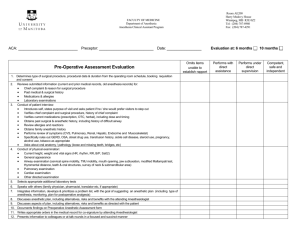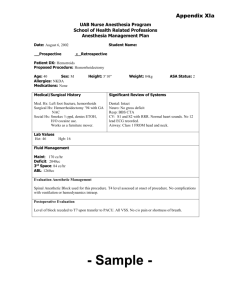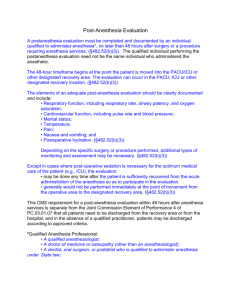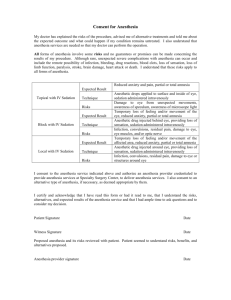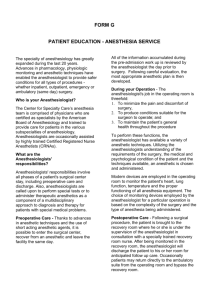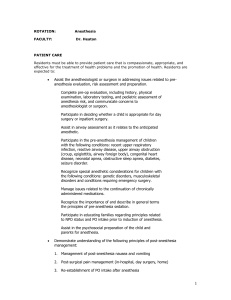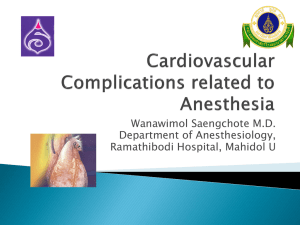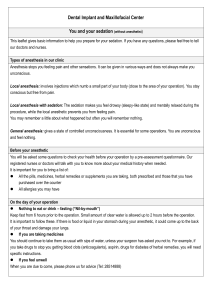WRHA ANAESTHESIA PROGRAM
advertisement
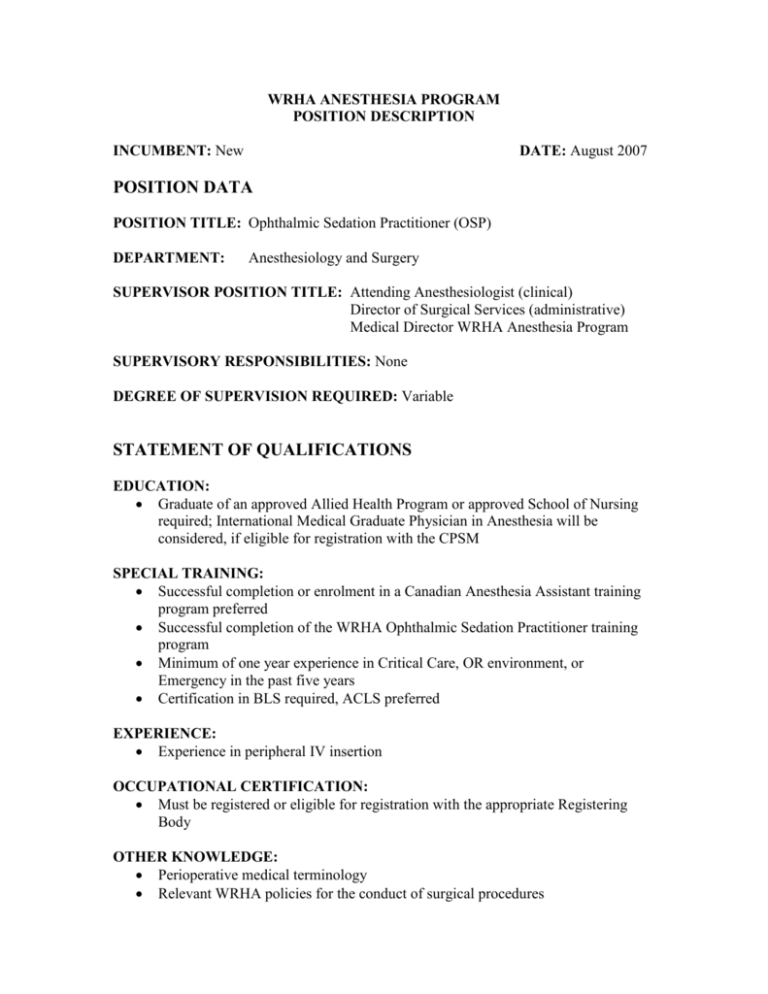
WRHA ANESTHESIA PROGRAM POSITION DESCRIPTION INCUMBENT: New DATE: August 2007 POSITION DATA POSITION TITLE: Ophthalmic Sedation Practitioner (OSP) DEPARTMENT: Anesthesiology and Surgery SUPERVISOR POSITION TITLE: Attending Anesthesiologist (clinical) Director of Surgical Services (administrative) Medical Director WRHA Anesthesia Program SUPERVISORY RESPONSIBILITIES: None DEGREE OF SUPERVISION REQUIRED: Variable STATEMENT OF QUALIFICATIONS EDUCATION: Graduate of an approved Allied Health Program or approved School of Nursing required; International Medical Graduate Physician in Anesthesia will be considered, if eligible for registration with the CPSM SPECIAL TRAINING: Successful completion or enrolment in a Canadian Anesthesia Assistant training program preferred Successful completion of the WRHA Ophthalmic Sedation Practitioner training program Minimum of one year experience in Critical Care, OR environment, or Emergency in the past five years Certification in BLS required, ACLS preferred EXPERIENCE: Experience in peripheral IV insertion OCCUPATIONAL CERTIFICATION: Must be registered or eligible for registration with the appropriate Registering Body OTHER KNOWLEDGE: Perioperative medical terminology Relevant WRHA policies for the conduct of surgical procedures ABILITIES AND SKILLS: Demonstrates effective organizational (task management), interpersonal (team working), critical thinking and problem solving (situational awareness and decision making) abilities Exhibits superior clinical monitoring skills characterized by watchfulness, vigilance and attention to detail Communicates perioperative information in a concise, clear, orderly and effective manner, orally and in writing Exhibits patience, understanding and compassion when working with the elderly population Exudes a calm, quiet, confident demeanour Posses an excellent command of the English language PURPOSE OF POSITION Under the supervision of the Anesthesiologist, the Ophthalmic Sedation Practitioner is responsible for: performing selective pre-operative assessment, anesthesia monitoring of physiological patient variables, administration of sedative and analgesic drugs used to establish up to a moderate level of sedation and rescue of patients who exhibit adverse consequences of a deeper than intended level of sedation. Additional aspects of anesthetic care include: point of care testing for glucose, INR and EKG, operating room readiness (machine, monitors, equipment, supplies, drugs), patient positioning, medical record keeping, recognition of complications of anesthesia and surgery, patient transport and transfer of care to PACU staff. STATEMENT OF RESPONSIBILITIES Sets up, calibrates, maintains and troubleshoots anesthesia machines, physiologic monitors and O2 delivery devices used in anesthesia and resuscitation Prepares and labels anesthetic medications Reviews pre-anesthetic patient history and physical, pre-operative consults and lab data Identifies relevant pre-existing medical, pharmacologic, airway, and ophthalmic conditions which may affect the patient’s suitability for the planned surgical and anesthetic procedure including physical limitations that may impact intraoperative care (for example, inability to lie flat, claustrophobia, dementia, significant tremor or nystagmus, hearing impairment, language barrier, shortness of breath at rest) Communicates these conditions to the Ophthamologist/Anesthesiologist to receive direction on management and/or an alternative plan of care Establishes peripheral IV access as required Operates point of care testing devices as required Administers oral preoperative sedation as required Initiates and utilizes multi-parameter monitoring of patients prior to, during and after the surgical procedure (oxygen saturation, non-invasive blood pressure, three or five electrocardiogram, respiration, heart rate +/- capnography or other monitors as directed by an Anesthesiologist) Pays particular attention to patient positioning, warmth and comfort and other interventions known to reduce O2 consumption and the need for IV sedation Follows a predetermined, patient specific, anesthetic management plan Participates in correct site policy and time out exercise Has basic understanding of ophthalmic anatomy and pathology Understands and prepares for complications of orbital regional anesthesia and ophthalmic surgical procedures Administers, maintains and monitors sedation and analgesia within authorized limits; titrates administration of sedation and analgesia during the surgical procedure; Demonstrates knowledge of the pharmacology of all drugs being administered Identifies and makes necessary adjustments in non-pharmacologic aspects of anesthetic care in order to facilitate the surgical procedure Detects abnormal physiological parameters, understands their significance and seeks assistance in management of same Provides airway management including O2 therapy, bag/mask ventilation, jaw thrust, chin lift, nasal/oral airway insertion and suctioning as required Intervenes to treat desaturation, bradycardia, tachycardia, hypotension, hypertension, arrhythmias, hypoventilation/apnea, anxiety and claustrophobia under the guidance of the Anesthesiologist Provides safe transfer into PACU Assists with postoperative pain control and treatment of nausea and vomiting as required; Accepts verbal orders from the Anesthesiologist and acts on same Initiates resuscitation by using current cardiac life support guidelines as required Legibly documents the patient’s medical and anesthetic management in relevant sections of the health record Adheres to all safety and health regulations and safe work practices May be required to perform other duties and functions related to the position description, not exceeding above stated abilities and skills POSITION ELEMENTS ENVIRONMENTAL CONDITIONS: Position involves physical activities such as walking, standing, transferring patients and equipment May encounter exposure to disease, radiation, toxic materials, noise, allergens, etc. May encounter aggressive and/or agitated individuals IMPACT OF ERROR: Inappropriate/insensitive communication, action or poor judgement may adversely affect patient care, or negatively impact the hospital’s reputation Non-adherence to hospital policies and procedures may cause harm to individuals, equipment or property WORKING RELATIONSHIPS: Liaises with other health care team members in the provision of Ophthalmological surgical care Collaborates with physicians and other professional health staff in the facility AUTHORITY: Has the authority to provide patient care if competent to provide that care, the care is endorsed in the practice setting and the care is within the scope of practice as defined by the governing body with which he/she is registered
